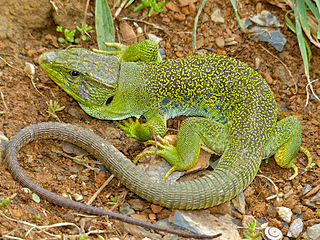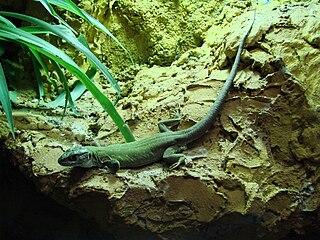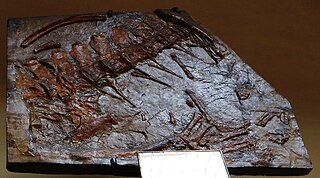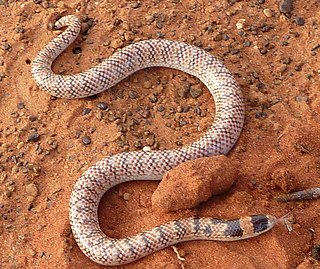
The Lacertidae are the family of the wall lizards, true lizards, or sometimes simply lacertas, which are native to Afro-Eurasia. It is a diverse family with at about 360 species in 39 genera. They represent the dominant group of reptiles found in Europe.

Xenagama is a genus of lizards in the family Agamidae. Species of the genus are native to Ethiopia and Somalia.

Tropidurus is a genus of reptiles. The genus includes many species of Neotropical ground lizards. Tropidurus is the type genus of the family Tropiduridae.

Monitor lizards are lizards in the genus Varanus, the only extant genus in the family Varanidae. They are native to Africa, Asia, and Oceania, and one species is also found in the Americas as an invasive species. About 80 species are recognized.

Lacerta is a genus of lizards of the family Lacertidae.

Gerrhonotus is a genus of anguid lizards that are commonly referred to as alligator lizards, due to a vague resemblance to an alligator. Most species are restricted to Mexico, but a few range into Guatemala or Texas, and G. rhombifer is from Costa Rica and Panama. Along with glass lizards (Ophisaurus) and many other lizards, alligator lizards have the ability to regrow their tail.

George Albert Boulenger was a Belgian-British zoologist who described and gave scientific names to over 2,000 new animal species, chiefly fish, reptiles, and amphibians. Boulenger was also an active botanist during the last 30 years of his life, especially in the study of roses.

The ocellated lizard or jewelled lizard is a species of lizard in the family Lacertidae. The species is endemic to southwestern Europe.

Timon pater is a species of lizard in the family Lacertidae, the wall lizards. The species is endemic to Northwest Africa.

Timon princeps, commonly called the Siirt lizard or the Zagrosian lizard, is a species of lizard in the family Lacertidae. The species is endemic to Western Asia.

Neustosaurus is a genus of marine crocodyliform from the Early Cretaceous. Neustosaurus was a carnivore that spent much, if not all, its life out at sea. No Neustosaurus eggs or nest have been discovered, so little is known of the reptile's lifecycle, unlike other large marine reptiles of the Mesozoic, such as plesiosaurs or ichthyosaurs which are known to give birth to live young out at sea. Where Neustosaurus mated, whether on land or at sea, is currently unknown. The name Neustosaurus means "Swimming lizard", and is derived from the Greek Neustos- ("swimming") and σαῦρος -sauros ("lizard").

The Madeiran wall lizard is a species of lizard in the family Lacertidae. It is the only species in the genus Teira. The species is endemic to the Madeira Archipelago, Portugal. In the Azores, this lizard has become naturalized after involuntary introduction by the shipping trade between the two archipelagos. There are four recognized subspecies.

The Atlas dwarf lizard, commonly known as Andreansky's lizard, is the only species in the genus Atlantolacerta, in the wall lizard family, Lacertidae. The species is indigenous to north-western Africa.

Timon tangitanus, commonly known as the Moroccan eyed lizard, is a species of lizard in the family Lacertidae. The species is endemic to Northwest Africa.

Simoselaps, or Australian coral snakes, is a genus composed of 12 species of venomous elapid snakes.

Trioceros is a genus of lizards in the family Chamaeleonidae, the chameleons, native to lowlands and highlands in the African mainland, ranging from Ethiopia south to Mozambique and west as far as Ghana. Trioceros was considered a subgenus of the genus Chamaeleo until 2009, when it was elevated to full genus level.

The peach-throated monitor, also known commonly as the Sepik monitor, is a species of monitor lizard in the family Varanidae. The species is native to New Guinea.

The blue-tailed monitor, blue-tailed tree monitor or Kalabeck's monitor, is a monitor lizard of the Varanidae family. It belongs to the V. doreanus group of the subgenus Euprepiosaurus.

Kings' monitor, also known commonly as Kings' goanna, Kings' rock monitor and pygmy rock monitor, is a small species of monitor lizard in the family Varanidae. The species is native to Australia.



















